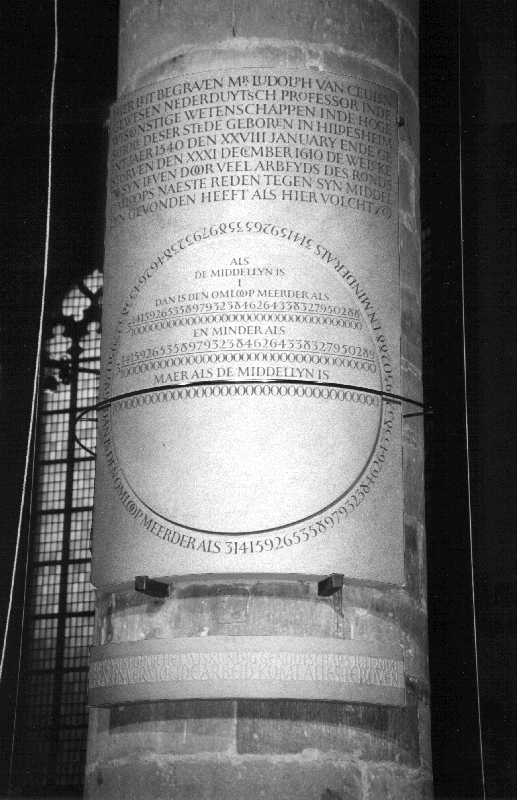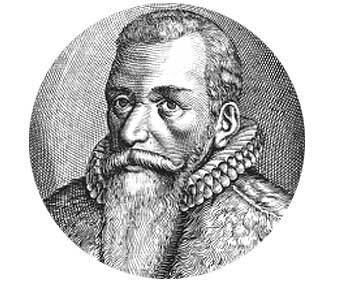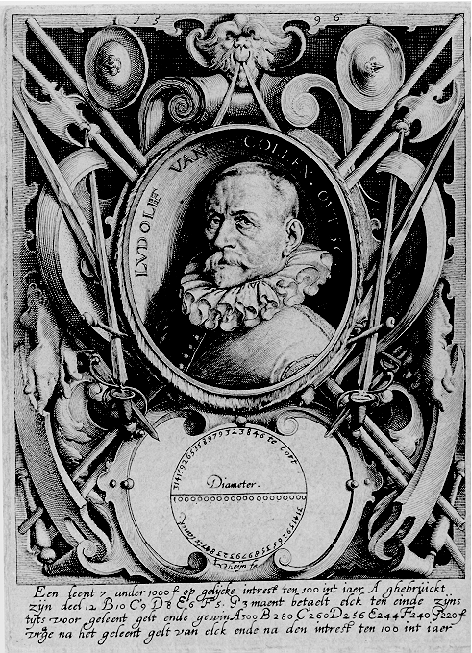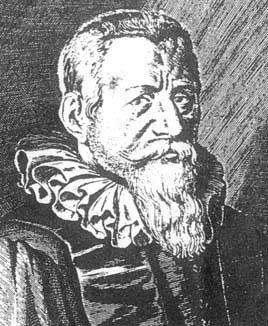Known for pi Role Mathematician | Name Ludolph Ceulen | |
 | ||
Notable students Willebrord Snellius, Frans van Schooten Sr. | ||
Ludolph van Ceulen
Ludolph van Ceulen ( [fan ˈkɔʏlən], [vɑŋˈkøːlə(n)]; 28 January 1540 – 31 December 1610) was a German-Dutch mathematician from Hildesheim. He emigrated to the Netherlands.
Contents

7de klas PI verhaal Ludolph van Ceulen
Biography

Van Ceulen moved to Delft to teach fencing and mathematics and in 1594 opened a fencing school in Leiden. In 1600 he was appointed the first professor of mathematics at the Engineering School, Duytsche Mathematique, established by Prince Maurice of Orange at the relatively new Leiden University. He shared this professorial level at the school with the surveyor and cartographer, Simon Fransz van Merwen, which shows that the intention was to promote practical, rather than theoretical instruction.

The curriculum for the new Engineering School was devised by Simon Stevin who continued to act as the personal advisor to the Prince. At first the professors at Leiden refused to accept the status of Van Ceulen and Van Merwen, especially as they taught in Dutch rather than Latin. Theological professors generally believed that practical courses were not acceptable studies for a university, but they were not willing to reject the School outright since it was founded by Prince Maurice.

Leiden University governors heard in April 1600 that Adriaan Metius, a fortification advisor to Prince Maurice and the States General, had been recruited and raised to the level of a full professor to teach mathematics at the rival Franeker University The Leiden governors' main problem was to match Franeker University, without raising the status too much of Duytsche Mathematique. So they quickly recruited mathematician Rudolf Snellius to the university—as distinct from the Engineering School—but then relegated him to the Arts faculty.

When the first degrees were to be conferred on Engineering School graduates in 1602 (under protest from the University) the governors and University's senate refused to award them except via an examination conducted by the Universities' own mathematics professor, Rudolf Snellius—ensuring that Van Ceulen and Van Merwen were seen as inferior to the university's own mathematician.

However Rudolf Snellius and his son Willebrord Snellius (the formulator of Snell's law—who replaced his father) both taught mathematics at Leiden University and appear to have cooperated closely with Van Ceulen, Van Merwen, Simon Stevin and the Engineering School. Willebrord Snellius, in fact, worked closely with Stevin.

Van Ceulen died in Leiden in 1610.
Calculating π
Ludolph van Ceulen spent a major part of his life calculating the numerical value of the mathematical constant π, using essentially the same methods as those employed by Archimedes some seventeen hundred years earlier. He published a 20-decimal value in his 1596 book Van den Circkel ("On the Circle"), which was published before he moved to Leiden, and he later expanded this to 35 decimals. After his death, the "Ludolphine number",
3.14159265358979323846264338327950288...,was engraved on his tombstone in Leiden. The tombstone was eventually lost, but later restored in 2000.
